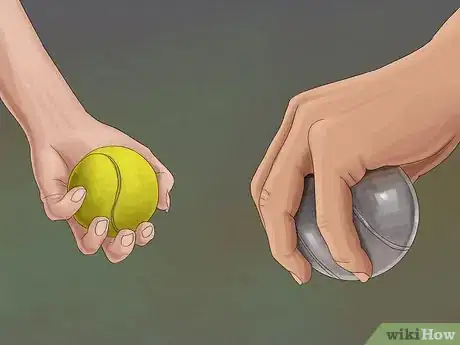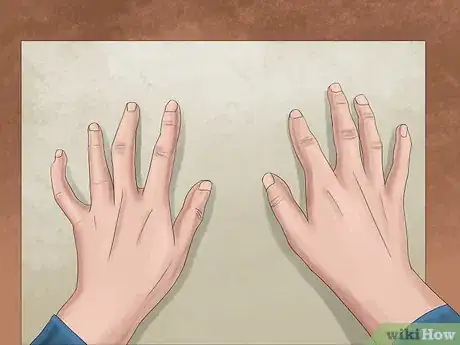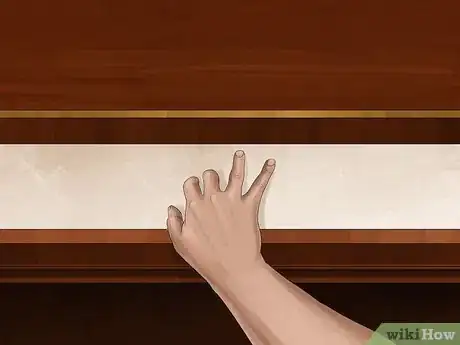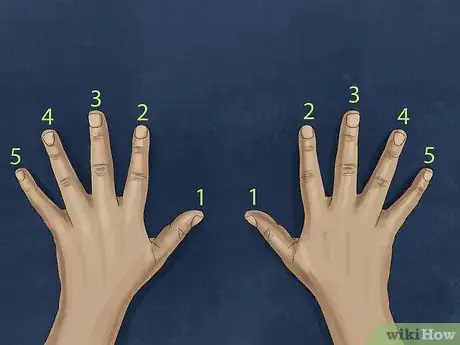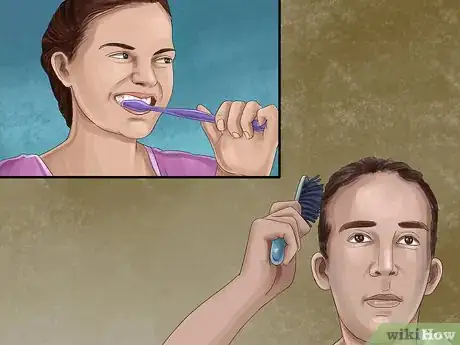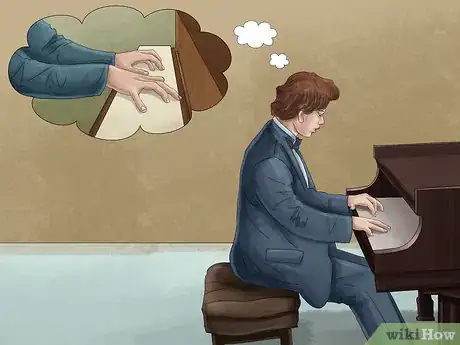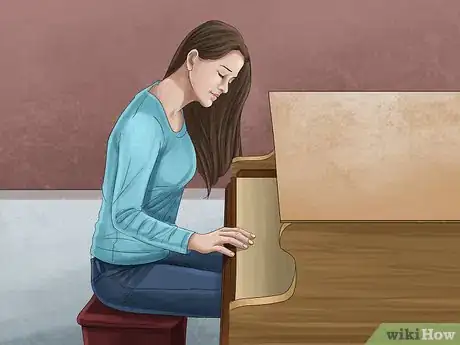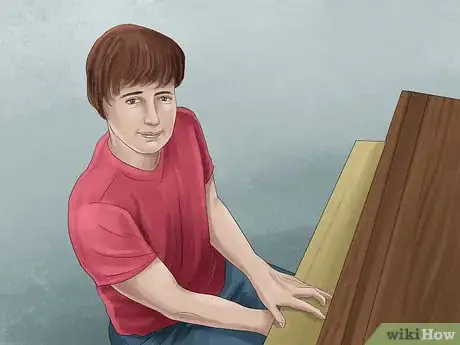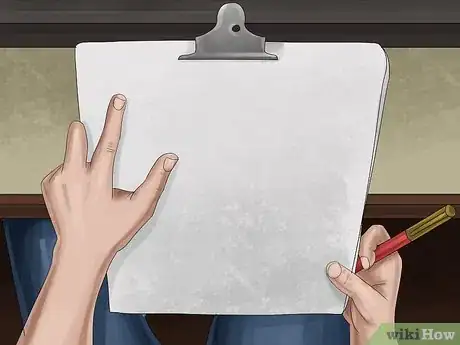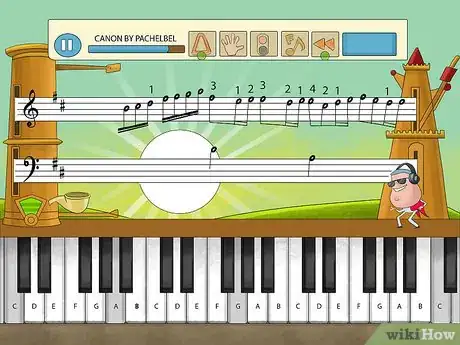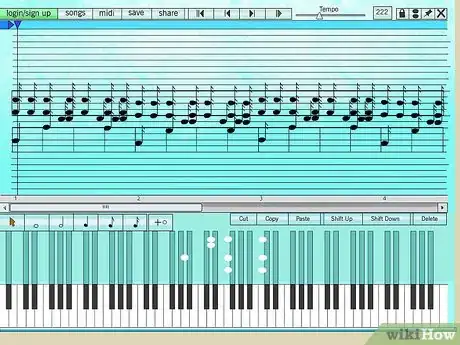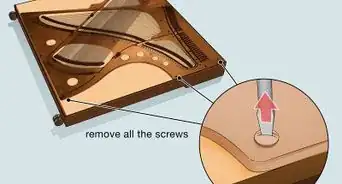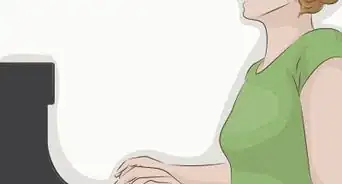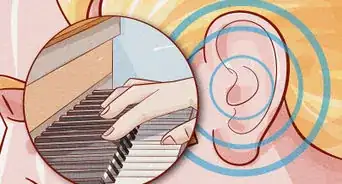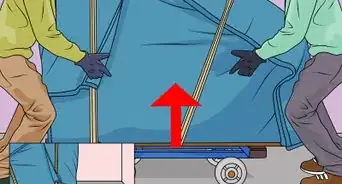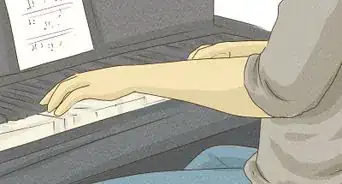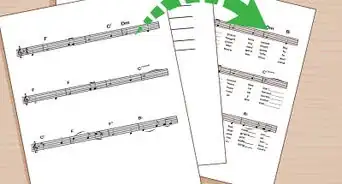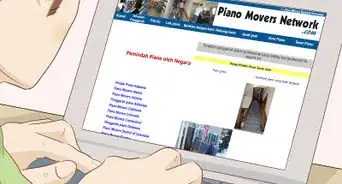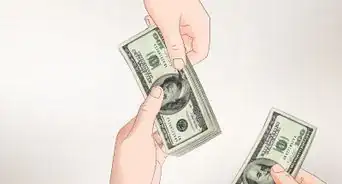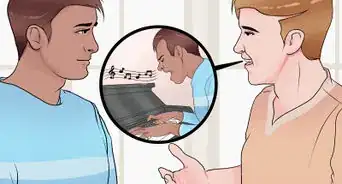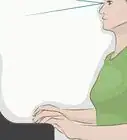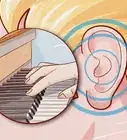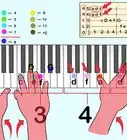This article was co-authored by Michael Noble, PhD. Michael Noble is a professional concert pianist who received his PhD in Piano Performance from the Yale School of Music. He is a previous contemporary music fellow of the Belgian American Educational Foundation and has performed at Carnegie Hall and at other venues across the United States, Europe, and Asia.
There are 10 references cited in this article, which can be found at the bottom of the page.
This article has been viewed 78,335 times.
It might seem counterintuitive, but it’s actually beneficial to practice piano away from your instrument. Exercise your fingers by tapping them on a tabletop as if you were striking keys. When you tap away, do rhythm finger drills or play through an entire song. If you need to memorize a piece, study the score 1 bar at a time and tap each hand’s part on the tabletop. Gradually build up parts and bars until you’ve worked through the entire song. Whether you play at an advanced level or are just starting out, you could also try using a number of helpful practice apps.
Steps
Finger Exercises
-
1Practice proper hand shape. When you play the piano, your hands need to be rounded and relaxed. Try holding a ball or placing your hands on your kneecaps. Notice how your fingers gently curve, and practice keeping your fingers in that shape.[1]
- When your fingers curve in a proper hand shape for piano, they shouldn’t be bent or tense. You should be able to see all 3 knuckles on each finger. Keep your wrists relaxed as well.
-
2Practice scales on a tabletop. Work on your finger coordination by playing scales on a table as if it were an actual piano. As you ascend a scale with your right hand, practice crossing your thumb to play a scale’s fourth note. Then descend the scale and practice crossing your middle finger to play the sixth note.[2]
- As you ascend a scale with your left hand, cross your middle finger to play the sixth note. When descending with your left hand, play the third note with your thumb.
Advertisement -
3Do finger rhythm drills. Starting with your thumb and ending with your pinky, tap all 5 fingers as if you were tapping the keys from middle C to G. Tap extra hard every third tap to create an accent rhythm.[3]
- Ascend and descend, or tap from your thumb to your pinky, then from your pink to your thumb. Tap as fast as you can while keeping the accent rhythm. Switch up the intervals you accent and add combinations, such as accenting every second and fourth taps.
-
4Try combination taps. Number your fingers 1 through 5 from your thumb to your pinky. Pick a combination of numbers, such as 1, 2, and 5. Practice tapping with your thumb, index finger, and pinky in that order.[4]
- Switch up your combinations and make them more complex. Try tapping as fast as you without making any mistakes.
-
5Spend extra time practicing with your non-dominant hand. Practicing scales and drills with your non-dominant hand can help you improve your coordination and dexterity. In addition to practicing, you could try brushing your teeth, combing your hair, and performing other tasks with your non-dominant hand.[5]
-
6Play a full piece on a tabletop as if the table were a piano. You can practice playing a piece on a tabletop either from a score or by memory. Try to imagine playing it as vividly as possible. Do your best to hear every note and feel your fingers strike the piano keys.[6]
- Playing on a tabletop is great for your muscle memory. Even though you’re not at the piano, you’ll still help train your fingers to follow a piece’s rhythm.
-
7Practice using online video guides. When you're away from the piano, watch and practice along with video lessons. You can work on your fingers' dexterity, brush up on notes, scales, and other basics, or get expert instruction on more advanced techniques.[7]
- Berklee College of Music has helpful free video lessons for beginners: http://www.berkleeshares.com.
Sheet Music Memorization
-
1Study sheet music 1 hand and 1 bar at a time. Start by reading the right hand melody for the piece’s first bar. Study it closely, then proceed to playing it on a tabletop when you believe you have it memorized.[8]
- If you need sheet music, a quick online search will yield websites and apps that provide scores for tens of thousands of songs. You can also purchase print or digital books online or at a music store.
-
2Play the bar’s right hand melody. After studying the first bar’s right hand part, start playing it on a tabletop as if it were a piano. Try to play the part 4 or 5 times without looking at the score. As you practice, do your best to vividly imagine the sound of the melody and the feeling of your fingers striking the keys.[9]
-
3Practice the bar’s left hand part. Move on to the left hand chords or melody when you’re confident that you have the first bar’s right hand part memorized. Study the score carefully, then practice playing with your left hand from memory.[10]
-
4Combine both hands and add more bars gradually. When you’re comfortable with the left hand, practice playing both hands together. Repeat the process to memorize the next bar, then gradually build parts and bars until you’ve worked through the entire piece.[11]
-
5Check the score to make sure you’re playing the right notes. Every now and then, read the score as you play the piece to ensure you’re memorizing the tune correctly. You wouldn’t want to accidentally get the wrong notes stuck in your mind.[12]
-
6Imagine the sound you want to create. Think about what kind of sound you want the piano to produce and what kind of shape you're giving each phrase. This type of mental practice can actually allow you to change the way you approach the piano for the better and help you come up with a convincing or unique interpretation of a piece.
- Mental practice without the physical motions can be very useful for intermediate or advanced players.
Piano Practice Apps
-
1Try using an app that teaches basic piano skills. If you’re just starting out, try using a free beginner’s app, such as JoyTunes Piano Maestro. It includes interactive exercises and games, and it tracks your progress and gives you feedback based on your playing.[13]
-
2Download a sight reading app. Sight reading, or reading and playing a score at first sight, is an essential skill, but it can be tough to master. Try apps like Read Ahead and SightRead4Piano to drill your sight reading abilities. Both apps have free demo practices, but you’ll need to pay to access more levels.[14]
-
3Watch a virtual piano play a score note by note. For unfamiliar or complex pieces, it can be helpful to see what the keys should look like as they're struck during tricky rhythms. The Plern Piano app allows you to upload music and creates a representation of keys being struck as the music scrolls across the page.[15]
- Plern Piano also allows you to compose and virtually play pieces from scratch.
Expert Q&A
Did you know you can get premium answers for this article?
Unlock premium answers by supporting wikiHow
-
QuestionCan you learn piano on a keyboard?
 Michael Noble, PhDMichael Noble is a professional concert pianist who received his PhD in Piano Performance from the Yale School of Music. He is a previous contemporary music fellow of the Belgian American Educational Foundation and has performed at Carnegie Hall and at other venues across the United States, Europe, and Asia.
Michael Noble, PhDMichael Noble is a professional concert pianist who received his PhD in Piano Performance from the Yale School of Music. He is a previous contemporary music fellow of the Belgian American Educational Foundation and has performed at Carnegie Hall and at other venues across the United States, Europe, and Asia.
Professional Pianist
-
QuestionDo you need to own a piano to take lessons?
 Michael Noble, PhDMichael Noble is a professional concert pianist who received his PhD in Piano Performance from the Yale School of Music. He is a previous contemporary music fellow of the Belgian American Educational Foundation and has performed at Carnegie Hall and at other venues across the United States, Europe, and Asia.
Michael Noble, PhDMichael Noble is a professional concert pianist who received his PhD in Piano Performance from the Yale School of Music. He is a previous contemporary music fellow of the Belgian American Educational Foundation and has performed at Carnegie Hall and at other venues across the United States, Europe, and Asia.
Professional Pianist
-
QuestionCan I learn to play piano without a piano?
 Michael Noble, PhDMichael Noble is a professional concert pianist who received his PhD in Piano Performance from the Yale School of Music. He is a previous contemporary music fellow of the Belgian American Educational Foundation and has performed at Carnegie Hall and at other venues across the United States, Europe, and Asia.
Michael Noble, PhDMichael Noble is a professional concert pianist who received his PhD in Piano Performance from the Yale School of Music. He is a previous contemporary music fellow of the Belgian American Educational Foundation and has performed at Carnegie Hall and at other venues across the United States, Europe, and Asia.
Professional Pianist
References
- ↑ https://takelessons.com/blog/piano-practice-tips-and-exercises-z06
- ↑ https://www.youtube.com/watch?v=rodRvFrhnQA&feature=youtu.be&t=96
- ↑ https://www.youtube.com/watch?v=fDEYmZl84qs&feature=youtu.be&t=137
- ↑ https://www.youtube.com/watch?v=rodRvFrhnQA&feature=youtu.be&t=213
- ↑ http://www.lessonrating.com/students/expert-articles/piano/practice-without-a-piano/
- ↑ https://www.youtube.com/watch?v=fDEYmZl84qs&feature=youtu.be&t=60
- ↑ https://www.makeuseof.com/tag/top-5-sites-for-learning-piano-online/
- ↑ https://timtopham.com/how-to-practice-away-from-the-piano/
- ↑ https://timtopham.com/how-to-practice-away-from-the-piano/
- ↑ https://timtopham.com/how-to-practice-away-from-the-piano/
- ↑ https://timtopham.com/how-to-practice-away-from-the-piano/
- ↑ https://timtopham.com/how-to-practice-away-from-the-piano/
- ↑ https://www.forbes.com/sites/jordanshapiro/2015/08/29/this-app-will-teach-your-kid-to-play-the-piano/2/#118319e2233b
- ↑ https://timtopham.com/blog/best-ipad-apps-for-piano-teachers/
- ↑ https://www.makeuseof.com/tag/top-5-sites-for-learning-piano-online/
